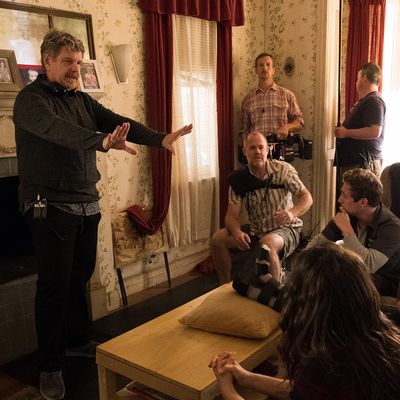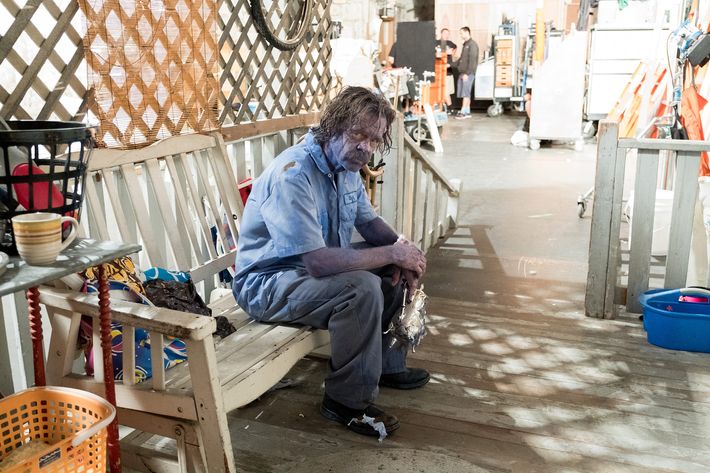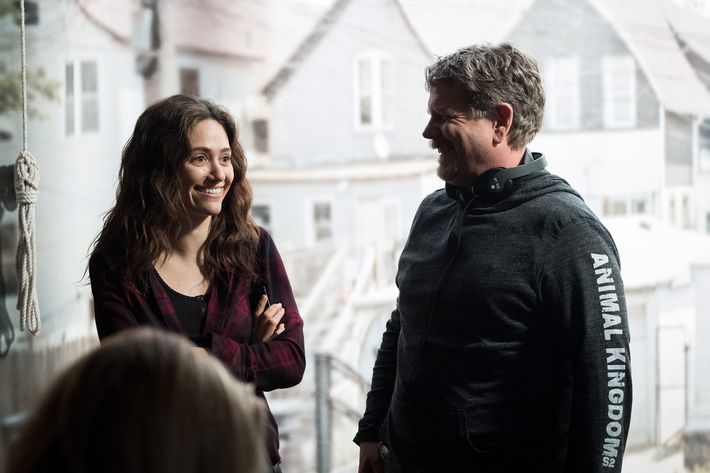
ÔÇ£Come on guys, gimme a hug!ÔÇØ
ItÔÇÖs 10:30 a.m. on the Warner Bros. lot in Burbank, California, and William H. Macy is covered head to toe in Smurf-blue paint and offering hugs to fellow crew members. The absurdity of the scene offers up some needed levity on set: During filming of ShamelessÔÇÖs first post-Trump season, the ugliness of U.S. politics has inevitably creeped into every conversation. This morning, ShamelessÔÇÖs executive producer John Wells and star Emmy Rossum are bemoaning recent headlines, namely Senator Bob CorkerÔÇÖs tweet that the White House has become ÔÇ£an adult day-care center.ÔÇØ Wells sighs heavily. ÔÇ£I went to an Adam Schiff fundraiser a few days ago, which made me feel better because heÔÇÖs actually a grown-up,ÔÇØ he says of the Democratic California congressman, whom many see as one of the struggling partyÔÇÖs rising stars.
Wells says he hopes the chaos enveloping the government, on both sides of the aisle, proves a positive bloodletting. ÔÇ£If thereÔÇÖs one good thing to come from the Trump era, itÔÇÖs increased awareness of how completely blind and clueless the ruling elite of our government has been about poverty,ÔÇØ says Wells. ÔÇ£The belief that we have a meritocracy in America ÔÇö that if people pull themselves up by their bootstraps they can climb the ladder ÔÇö is a lie. Like so many Americans, the Gallaghers were born into poverty. ItÔÇÖs not their fault.ÔÇØ
Since its 2011 debut on Showtime, WellsÔÇÖs faithful adaptation of Paul AbbottÔÇÖs U.K. series about Manchester drunk-deadbeat Frank Gallagher and his six kids has never explicitly been about politics. Or maybe it has: Shameless is unique in the TV landscape as the only series centered wholly on a family living in poverty, specifically a white family, in a world where scores of poor, disenfranchised Americans elected a garishly rich reality-TV star as their president.

One might assume that a Hollywood veteran like Wells, who ran NBCÔÇÖs lefty-leaning The West Wing from 1999 to 2006, would see his series about sticking-it-to-the-man as a poignant middle finger to the divisive current administration. Not so, he says. ÔÇ£Yes, I have very liberal tendencies,ÔÇØ says Wells. ÔÇ£But now more than ever, we are trying to skewer everything, whether thatÔÇÖs political correctness on the left or extreme conservative orthodoxy on the right.ÔÇØ Wells adds that forthcoming episodes of the eighth season, premiering Sunday night, absolutely were affected by current events. Among the hot-button issues explored early in the season are illegal immigration, the race and class divide in education, health-care costs, and one characterÔÇÖs foray into jingoisms like ÔÇ£America First, motherfucker.ÔÇØ
The show, he clarifies, will still be what itÔÇÖs always been. ÔÇ£Our mission with Shameless has always been to explore class in America,ÔÇØ Wells continues. ÔÇ£What happens when the system knocks you down? Who do we empathize with? Who do we ultimately want to be? TheyÔÇÖre questions the country is wrestling with in a very big way right now.ÔÇØ
Hollywood is struggling to reconcile them, too. How can development executives who live in tony communities like Brentwood and Bel Air ÔÇö enclaves that are arguably out of touch with the lives of ÔÇ£real AmericansÔÇØ ÔÇöbe qualified to green-light and curate stories about the poor and working class? ÔÇ£One is hard-pressed to cite another series besides Shameless about a family living in dire poverty,ÔÇØ says Reece Peck, a media culture professor at the City University of New York (CUNY) Staten Island. ÔÇ£Good Times, the 1970s sitcom about a black family living in a Chicago housing project, is the closest precedent. Then FoxÔÇÖs South Central and The PJs, but they were abruptly canceled. All of these, however, featured nonwhite families, conforming to the racialized, stereotypical image of the American poor. For this reason, Shameless breaks new ground.ÔÇØ
The lower-middle class, Peck says, has been the ÔÇ£lowest rung on the socioeconomic ladderÔÇØ that TV has generally been willing to explore in depicting white characters, as seen in such shows as ABCÔÇÖs long-running family sitcom The Middle and CBSÔÇÖs erstwhile Melissa McCarthy comedy Mike & Molly. Despite these, and a hearty glut of down-home reality programming thatÔÇÖs unabashedly targeted rural and working-class white audiences over the last decade (see: A&EÔÇÖs Duck Dynasty and TLCÔÇÖs Here Comes Honey Boo Boo), Hollywood has failed in delivering compelling, empathetic narratives about outlying Americans, and series featuring caricatures of white hillbilly-villains like those in NetflixÔÇÖs Ozark, FXÔÇÖs Justified, and WGNÔÇÖs Outsiders havenÔÇÖt helped.
ÔÇ£In the way cities have been designed to keep the poor and the homeless out of sight, these same groups have been mostly invisible in the terrain of American TV,ÔÇØ says Peck. ÔÇ£Shameless represents how poor communities carry resentment towards various upwardly-mobile class groups. ItÔÇÖs this plurality of class antagonism that allows both conservative and liberal viewers to see their own political identities reflected and affirmed by the show.ÔÇØ
Recent seasons have explored bipartisan cultural issues like gentrification: In one episode, Frank compares the influx of hipsters in his neighborhood to the imperial conquest of Europeans over Native Americans. ÔÇ£FrankÔÇÖs resistance to these attempts to ÔÇÿreformÔÇÖ the dysfunctional aspects of his family creates good comedy, but also critiques the aspirational values of the professional middle class and their assumption that the culture of working-class people needs fixing,ÔÇØ says Peck. ÔÇ£From this, conservative viewers could see the Gallaghers as sharing their antipathy for educated elites and as being simpatico with their anti-government ideology.ÔÇØ
ItÔÇÖs yet unclear how deeply Hollywood is looking to appeal to a wider swath of political and socioeconomic demos post-Trump. At least one network, ABC, announced after the 2016 election that it aims to find shows that appeal to the working class; itÔÇÖs currently rebooting its 1980ÔÇÖs Midwest-set sitcom Roseanne, with ShamelessÔÇÖs Emma Kenney (ÔÇ£Debbie GallagherÔÇØ) playing the daughter of Sara GilbertÔÇÖs character, Darlene. Meanwhile, Shameless has become a compelling case study. ItÔÇÖs now ShowtimeÔÇÖs youngest-skewing series, has the networkÔÇÖs largest social-media presence, and has grown consistently: season seven was its biggest yet with 6.5 million weekly viewers, a surge likely helped by the seriesÔÇÖ debut on Netflix in 2016.
It wasnÔÇÖt an easy sell, though. When Wells initially shopped the series to a handful of networks, including HBO and NBC, a common refrain emerged from the meetings. ÔÇ£They said, ÔÇÿWe donÔÇÖt think this world really exists in the United States,ÔÇÖÔÇØ says Wells. ÔÇ£And IÔÇÖd say, ÔÇÿWell I can tell you that it does exist because I grew up in and around it.ÔÇÖÔÇØ Also on WellsÔÇÖs pitch tour was Showtime, whose edgy lineup at the time included series like Dexter and Nurse Jackie; shows that programming president Gary Levine says didnÔÇÖt easily mesh with an ensemble-family conceit like Shameless, so the network initially passed. But in October 2009, they reconsidered.
ÔÇ£There are definitely myopic executives in Hollywood,ÔÇØ says Levine. ÔÇ£IÔÇÖve been in rooms where someone will say, ÔÇÿThat character is such a loser.ÔÇÖ IÔÇÖm like, ÔÇÿLoser? HeÔÇÖs one of the richest characters!ÔÇÖ I continued to love the Shameless script and these characters. It took a beat or two, but it was ultimately a happy ending.ÔÇØ
After a brisk assembling of the cast, a roster top-lined by WellsÔÇÖs friend Macy from their ER days and filled out by eleventh-hour hire Rossum, Shameless premiered in January 2011 to decent ratings and mixed-to-positive reviews. ÔÇ£[ItÔÇÖs a show] I didnÔÇÖt think IÔÇÖd be all that interested in, but quickly became one of the best things IÔÇÖve watched on TV,ÔÇØ wrote a reviewer in the Washington Post. The AV Club said, ÔÇ£IÔÇÖm not entirely sure what the show is supposed to be about,ÔÇØ and TV Guide wrote: ÔÇ£Shameless is what you might expect of a no-holds-barred family drama on pay cable: reckless, raw and always a bit much.ÔÇØ
Executive producer Nancy Pimental, a veteran of Comedy CentralÔÇÖs South Park, says ShamelessÔÇÖ blending of comedy, drama, and WTF moments (a typical challenge on the show is how to best intercut a scene where a character is dying with, say, another depicting a threesome) may have made it a difficult sell at first. ÔÇ£I donÔÇÖt think Hollywood thought audiences could handle such a flexible tone in their television,ÔÇØ says Pimental, citing that Shameless was among the first wave of recent high-concept series ÔÇö before AmazonÔÇÖs Transparent and the CWÔÇÖs Crazy Ex-Girlfriend ÔÇö to showcase such a raw, effective blending of genres. Peter Roth, president and chief content officer of Warner Bros. Television Group, the studio that makes Shameless, says itÔÇÖs the showÔÇÖs ability to depict painfully real themes through a comedic lens that makes it such a unique entity in the TV landscape. ÔÇ£IÔÇÖve called John [Wells] many times and said, ÔÇÿOkay, youÔÇÖve reached a new level of depravity this season,ÔÇÖÔÇØ says Roth. ÔÇ£Yet, I think the audience understands why Shameless is so special; that as dysfunctional as this family is, they love each other.ÔÇØ
Also distinct are ShamelessÔÇÖs rarely-seen depictions of poverty: The Gallaghers are shown exercising, going to college (or at least trying), embracing homosexuality, being entrepreneurial, using smartphones, and pontificating about politics, often via Frank GallagherÔÇÖs drunken rants about an America thatÔÇÖs now divided into ÔÇ£the rich and the fucked.ÔÇØ Wells says all of this thematic realism is meaningless if the series doesnÔÇÖt look and feel believable. So Shameless spends four weeks per season shooting on location in poor neighborhoods in and around Chicago (unlike ÔÇ£working-classÔÇØ series like All in the Family and Married With Children, which were filmed on Hollywood sets). ÔÇ£ItÔÇÖs important for the actors to be in Chicago because it feels and smells different than L.A,ÔÇØ Wells says.
It also adds a healthy dose of Gallagher-ian chaos to their process. Rossum reports there are many moments of ÔÇ£changing in church basementsÔÇØ and ÔÇ£trying not to pee on the ÔÇÿLÔÇÖ train,ÔÇØ while Macy calls being on-location a continuity nightmare. ÔÇ£YouÔÇÖll be on set in Los Angeles and have a big scene with someone where you walk out the door of the Gallagher house in a huff,ÔÇØ he says. ÔÇ£Then a month and a half later, weÔÇÖll pick up the same scene in Chicago. ItÔÇÖs insane.ÔÇØ

While the series has gained a devoted fan base, HollywoodÔÇÖs lauding of Shameless has proven more elusive. Wells was so frustrated that his writers and actors werenÔÇÖt being recognized, he lobbied the Television Academy successfully in 2014 to move the series from the drama to comedy category in hopes that voters would connect better with the seriesÔÇÖ outlandish, funny moments. Beyond netting Macy four nominations for best lead actor* in a comedy, the shift hasnÔÇÖt proven fruitful. ÔÇ£Emmy Rossum is so brilliant and fearless, it galls me that we canÔÇÖt get her nominated,ÔÇØ admits Levine.
For Wells, the most meaningful metric of success comes from those who actually live the seriesÔÇÖ gritty reality. He says he loves when South Side locals tell him that Shameless accurately and respectfully captures their world, and the cast and crew have grown close to the real-life family who live inside the Gallagher home. ÔÇ£In fact, theyÔÇÖve used the money theyÔÇÖve earned to fix up their house, so our scenic team has had to work magic to make sure it still looks convincingly crappy for us to shoot,ÔÇØ he laughs. ÔÇ£This makes me very happy.ÔÇØ
*A previous version of this story stated that Macy was nominated for best supporting actor at the Emmys. He has in fact been nominated in the lead actor category.

